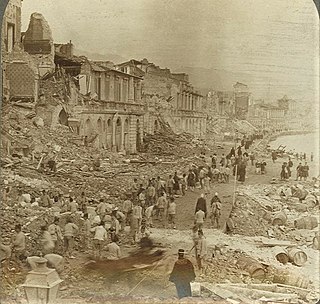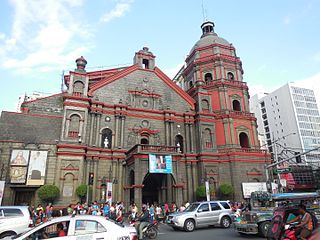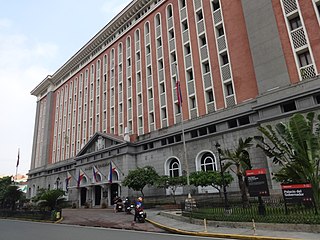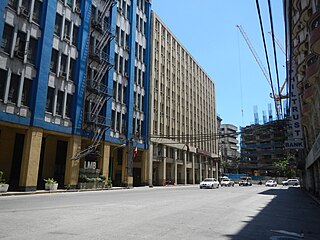
Intramuros is the 0.67-square-kilometer (0.26 sq mi) historic walled area within the city of Manila, the capital of the Philippines. It is administered by the Intramuros Administration with the help of the city government of Manila.

The Church of Saint Augustine, also known as the Archdiocesan Pontifical Shrine of Our Lady of Consolation and Cincture or the Immaculate Conception Parish, is a Roman Catholic church under the auspices of the Order of Saint Augustine located inside the historic walled city of Intramuros in Manila, Philippines. Completed in 1607, it is the oldest stone church in the country.

The Battle of Manila was a major battle of the Philippine campaign of 1944–45, during the Second World War. It was fought by forces from both the United States and the Philippines against Japanese troops in Manila, the capital city of the Philippines. The month-long battle, which resulted in the death of over 100,000 civilians and the complete devastation of the city, was the scene of the worst urban fighting fought by American forces in the Pacific theater. Japanese forces committed mass murder against Filipino civilians during the battle and American firepower killed many people. Japanese resistance and American artillery also destroyed much of Manila's architectural and cultural heritage dating back to the city's founding. Manila became one of the most devastated capital cities during the entire war, alongside Berlin and Warsaw. The battle ended the almost three years of Japanese military occupation in the Philippines (1942–1945). The city's capture was marked as General Douglas MacArthur's key to victory in the campaign of reconquest. To date, it is the last of the many battles fought within Manila's history.

The Baroque Churches of the Philippines are a collection of four Spanish Colonial-era baroque churches in the Philippines, which were included in UNESCO's World Heritage List in 1993. The churches are also considered as national cultural treasures of the country.

The 1990 Luzon earthquake struck the island of Luzon in the Philippines at 4:26 p.m. on July 16 (PDT) or 3:26 p.m. (PST) with an estimated moment magnitude of 7.7 and a maximum Mercalli intensity of IX (Violent) and produced a 125 km-long ground rupture that stretched from Dingalan, Aurora to Kayapa, Nueva Vizcaya. The event was a result of strike-slip movements along the Philippine Fault and the Digdig Fault within the Philippine Fault System. The earthquake's epicenter was near the town of Rizal, Nueva Ecija, northeast of Cabanatuan. An estimated 1,621 people were killed, most of the fatalities located in Central Luzon and the Cordillera region.

The 1908 Messina earthquake occurred on 28 December in Sicily and Calabria, southern Italy with a moment magnitude of 7.1 and a maximum Mercalli intensity of XI (Extreme). The epicentre was in the Strait of Messina which separates Sicily from the Italian mainland. The cities of Messina and Reggio Calabria were almost completely destroyed and between 75,000 and 82,000 people died. It was the most destructive earthquake ever to strike Europe.

The Minor Basilica and Metropolitan Cathedral of the Immaculate Conception, also known as the Manila Cathedral, is the cathedral of Manila and basilica located in Intramuros, the historic walled city within today's modern city of Manila, Philippines. It is dedicated to the Immaculate Conception of the Blessed Virgin Mary as the Patroness of the country. The cathedral serves as the episcopal seat of the Archbishop of Manila.

The Our Lady of Remedies Parish, also known as Malate Church, is a parish church in the district of Malate in the city of Manila, Philippines. This Mexican Baroque-style church is overlooking Plaza Rajah Sulayman and, ultimately, Manila Bay. The church is dedicated to Nuestra Señora de los Remedios, the patroness of childbirth. A revered statue of the Virgin Mary in her role as Our Lady of Remedies was brought from Spain in 1624 and stands at the altar.
The 1645 Luzon earthquake was one of the most destructive earthquakes to hit the Philippines. It occurred on November 30 at about 08:00 PM local time on Luzon Island in the northern part of the country. The island was struck by a 7.5 tremor produced by the San Manuel and Gabaldon Faults in the central section of the island.

Binondo Church, formally known as the Minor Basilica and National Shrine of Saint Lorenzo Ruiz - Parish of Our Lady of the Most Holy Rosary, is located in the District of Binondo, Manila fronting Plaza San Lorenzo Ruiz, in the Philippines. This church was founded by Dominican priests in 1596 to serve their Chinese converts to Christianity. The original building was destroyed in 1762 by British bombardment. A new granite church was completed on the same site in 1852 however it was greatly damaged during the Second World War, with only the western façade and the octagonal belfry surviving.
The earthquakes of July 1880 in Luzon, the largest island of the Philippines, were one of the most destructive tremors on record in the history of the country. The shocks continued, with greater or less interruption, from the 14th to the 25th of the month, highlighted by three violent shaking events, which destroyed churches and other buildings, producing loss of life. Coinciding with the tectonic activity was an increase in volcanic activity in Taal Volcano in southwestern Luzon.

Plaza San Lorenzo Ruiz or Plaza Lorenzo Ruiz is a major public square in Binondo, Manila, bounded by Quintin Paredes Street to the east and Juan Luna Street to the west, parallel to the Estero de Binondo. It is the plaza that fronts the Minor Basilica of San Lorenzo Ruiz, one of the main churches of the City of Manila, and is considered the center of Binondo as a whole.

The Ayuntamiento de Manila is a building located at the corner of Andrés Soriano Avenue and Cabildo Street, fronting Plaza de Roma in Intramuros, Manila, Philippines. Also known as the Casas Consistoriales and also nicknamed as the Marble Palace, the Ayuntamiento was the seat of the Manila City Council, which consisted of two alcaldes, eight oidores (judges), a clerk, and a chief constable. Destroyed in World War II and reconstructed thereafter, the building now houses the offices of the Bureau of the Treasury.

Basco Cathedral, canonically named as Our Lady of the Immaculate Conception Cathedral, and commonly known as Santo Domingo Church, is a Roman Catholic cathedral church located in Basco, Northern Batan Island, Batanes, Philippines.

Vigan Cathedral, canonically known as the Metropolitan Cathedral of the Conversion of St. Paul the Apostle is a Roman Catholic cathedral in Vigan, Ilocos Sur, Philippines. It serves as the seat of the Roman Catholic Archdiocese of Nueva Segovia. It is part of the UNESCO World Heritage Site declaration for the Historic Town of Vigan in 1999.

The Palacio del Gobernador is a government building located in Intramuros, Manila, Philippines. It is located southwest from Plaza de Roma and built in its current form in 1976. At present, the building houses the Intramuros Administration, the Commission on Elections and the Home Development Mutual Fund National Capital Region Office. It also previously housed the Bureau of the Treasury until it relocated across Plaza de Roma to the Ayuntamiento de Manila.

Plaza Cervantes is a public square in Binondo, Manila, bounded by Quintin Paredes Street to the east and Juan Luna Street to the west, near the Estero de Binondo. Dedicated to Spanish writer Miguel de Cervantes, it is one of three main plazas in Binondo, located between Plaza Moraga to the south and Plaza San Lorenzo Ruiz to the north.

On July 27, 2022, at 8:43:24 a.m. (PHT), an earthquake struck the island of Luzon in the Philippines. The earthquake had a magnitude of 7.0 Mw , with an epicenter in Abra province. Eleven people were reported dead and 615 were injured. At least 35,798 homes, schools and other buildings were damaged or destroyed, resulting in ₱1.88 billion (US$34 million) worth of damage.















